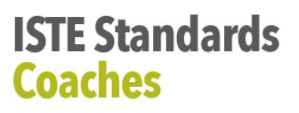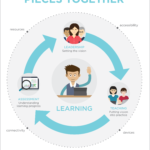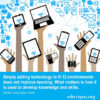
Professional Development and Program Evaluation
Technology coaches conduct needs assessments, develop technology-related professional learning programs, and evaluate the impact on instructional practice and student learning.
 a. Needs Assessment: Conduct needs assessments to inform the content and delivery of technology-related professional learning programs that result in a positive impact on student learning
a. Needs Assessment: Conduct needs assessments to inform the content and delivery of technology-related professional learning programs that result in a positive impact on student learning
b. Professional Learning: Design, develop and implement technology-rich professional learning programs that model principles of adult learning and promote digital age best practices in teaching, learning, and assessment
c. Program Evaluation: Evaluate results of professional learning programs to determine the effectiveness on deepening teacher content knowledge, improving teacher pedagogical skills and/or increasing student learning
Professional Development and Program Evaluation Summary:
Needs Assessment: Computer science education has a new focus area; researchers look for ways to improve human-computer interaction (HCI) to increase student learning. TheComputer Science community understood the need to create a way to teach the concepts of computer science without it becoming a language lesson. They understood that the teaching of syntax is not reasonable for younger students. The creation of “Blocky” programming allowed for the implementation of programming in the younger grades, even as young as kindergarteners. The tools are great for teaching content and allow for an improved comprehension and knowledge retention. These tools are learner-centered, and the instructional strategies have supported by the integration of scaffolding, modeling, and additional tools.
What do we need for learner-centered instruction? Learner-centered professional development, of course. The transition will require work, but many districts are already moving in this direction. It is through the dedication to improving the quality of teaching that we will see the largest impact on students’ learning. (See Post: Profesional Development in a Digital Age)
Professional Learning: Increasing teacher and student digital and media literacy start by embedding technology to improve student learning through professional development activities. Technology can benefit the classroom and can be used to provide authentic learning activities.
Professional development works best when building a culture focused on inclusive, collaborative, needs-based training that is ongoing, job-embedded and available just in time learning. Other elements of successful teacher professional development should create learning communities where teachers can share and discuss learning activities that they use with their students.
Teacher leaders have an impact since they understand the culture, as well as the needs and the majority of teachers, value the knowledge, innovation, and leadership of their peers. They show educators how to effectively use technology in their classroom, The same way as in professional learning, by integrating authentic learning activities. (See Posts: Adult Professional Development; Technology Embedded Professional Development)
Program Evaluation: The evaluation is a significant step in reviewing the effectiveness of a program that is working to increase student learning about a content area. The evaluation covers all aspects of the program and uses data to measure it is a success. The five phases of program evaluation rely on defining the need. Reviewing best practices and focus needed to determine the method for the evaluation and a planned approach for data collection. Before collecting data, planning to determine how it is gathered and stored to produce the intended results finalized. Analyzing data can require cleanup of the data to ensure that the analysis can be complete. The use of the program report defined in the beginning will result in whether the report will be a full report or an executive summary. (See report here: Practicum)
Fulfilling Professional Development and Program Evaluation Standards:
As the Computer Science Specialist, one of my duties is to work with $2 million in state funding that the legislature made available for computer science and education grants. These competitive grants allowed districts, schools, and nonprofits to train teachers; provide and upgrade technology; and expand access to girls, underrepresented students, and underserved communities.
Needs Assessment/Professional Learning:
I am currently preparing the Request for Proposal (RFP) for the next round of Computer Science grants. The funding could be anywhere from the $2 million we had in the previous biennium, to a suggested amount of $6 million, but there is also the slim chance that the grant is unfunded. This competitive grant while similar to the previous will be reflective of the data from the progress report that I completed. The needs and recommendations for implementing the Computer Science Standards in the next grant based on collected data and results. The data shows where there the increased investment resulted in increased student learning, but also what teacher professional learning made the most impact. The one clearly defined outcome is the professional learning needed about the Computer Science Standards. They are new enough that there is often confusion between them and the Educational Technology Standards.
Program Evaluation:
My role is to provide information in regards to the grants distribution and report the outcomes. I requested progress reports about activities through a structured self-report questionnaire collecting information on activities, matching grant agencies, standards focus, and data on student and teacher impacts. The questionnaire also explored events or situations related to individual grant proposal topics and experiences. I created a program evaluation from this data. The report was worked on throughout my practicum, and the results are on the Practicum page. (See report here: Practicum) http://msthissen.org/project/
Posts:

Professional Development in a Digital Age
Computer science education has shifted its focus to improving human-computer interaction(HCI) to improve student learning. The invention of new technologies like “Blocky” programming, allows us to move beyond teaching computer interfaces-- to improving comprehension and knowledge. Through the adding of tools that adapt to learners abilities and choices, technology designs are making it easier to use learner centered instructional strategies by supporting the integration of scaffolding, modeling and additional tools.
read more
Adult Professional Development
In the Educational Leadership journal of February 2009, Jason Margolis writes about strategies that teacher leaders can embed to engage their colleagues and realize the benefits of instructional changes. While there were a number of presentations reviewed, the strategies below produced “observable teacher engagement”. The one constant in these researches is that teachers value the knowledge, innovation and leadership of their peers.
read more
Technology embedded Professional Development
Technology can bring benefits to the classroom, and can be used to provide authentic learning activities. One way to help educators is to show them how to effectively use technology in their classroom, in the same way as we would our students, in authentic learning activities that are integrated as part of professional development. Increasing the effectiveness of professional development with authentic learning, integrating technology has the potential of increasing teacher performance.